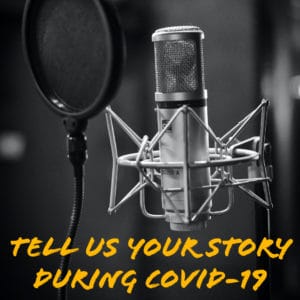 As we are experiencing this significant moment in time, one productive coping mechanism during the COVID-19 pandemic is to keep a record of our thoughts, emotions, and daily occurrences. What is happening today will someday be taught as history, and we all have a story to tell.
As we are experiencing this significant moment in time, one productive coping mechanism during the COVID-19 pandemic is to keep a record of our thoughts, emotions, and daily occurrences. What is happening today will someday be taught as history, and we all have a story to tell.
Below are examples of ways for you to tell your COVID-19 story.
Tell someone your story
Email the Maryland Historical Society
Maryland Historical Society (MdHS) has launched a new initiative called Collecting in Quarantine and they invite you to participate. How is the novel coronavirus/COVID-19 pandemic impacting your life? Submit your stories and photographs and help them document history in the making.
Whether you are staying at home in self-quarantine or working through the crisis – your story is unique and important. Marylanders abroad and healthcare workers are also encouraged to submit. MdHS is also asking business employees, owners, customers, passers-by and neighborhood residents to visually share their experiences so far. MdHS will create a photo essay illustrating the industrial spirit of Marylanders during this critical time.
Email submissions to [email protected]. Stories will be shared on Maryland Historical Society’s underbelly blog and on their social media pages using the hashtags #LettersFromtheHomeFrontMD and #CollectingInQuarantineMD.
Talk to Wired
Maryland’s voices matter. Wired writer Garrett Graff is seeking stories from a wide range of US residents to compile a portrait of a nation in the grip of Covid-19. He wants to know what you’re seeing in your home, on the streets, at the grocery stores, in the parks where you’re walking or running—at an appropriate social distance, of course. What are the sights of this pandemic to you? The sounds? The smells?
Email your stories to [email protected], write as much or as little as you wish, include a phone number, and then follow Wired’s project: Covid Spring—An Oral History of a Pandemic.
Tell your own story
Collect Oral Histories
Oral histories allow you to transform today’s events into living memories, as well as collect the stories of others. If you’re quarantined with friends, family, or roommates, this can be a great way to share the experience together.
The American Association for State and Local History provides a technical leaflet on A Guide to Oral History Interviews. This primer outlines every aspect of the interview process, from picking out the appropriate equipment for the interview to the forms that need to be filled out for proper ownership of the recording. Those new to the field of oral history will find the outline of what to do before, during, and after the interview particularly helpful as they prepare for their inaugural conversation.
The American Folklife Center also offers a guide to Planning Oral History Interviews. In order to get the most out of an oral history project, it is essential to develop a solid plan at the very beginning.
Create a Podcast
In a recent blog post we shared a variety of history podcasts and encouraged you to try producing one of your own.
If you create your own podcast, CRAB Radio (or another similar program) could potentially air it! Here’s how to start your planning: CRAB Radio’s show slots are 30 minutes each. This could be cut into two 14 minute segments or one 28 – 29 minute segment with the mandatory station ID at the beginning and a public service announcement at the end to complete the 30-minute time slot. CRAB Radio has provided resources to help you get started.
You can also read this article about Super Quick DIY Podcasting for Museums & Other Nonprofits Closed by COVID-19, which encourages you to think about we can use digital tools to stay active and be there for our audiences.
Have any other ideas on how to tell your COVID-19 story? Email us at [email protected]
